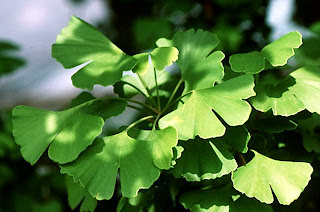Ginkgo biloba, gingko or Maidenhair Tree
Ginkgo biloba, gingko or Maidenhair Tree cultivated and introduced, since an early period in human history, and has various uses as a food and traditional medicine. Ginkgos are large trees, normally reaching a height of 20–35 m (66–115 feet) Ginkgo is a relatively shade-intolerant species that (at least in cultivation) grows best in environments that are well-watered and well-drained.
There are many specimens found along stream banks, rocky slopes, and cliff edges.Ginkgo branches grow in length by growth of shoots with regularly spaced leaves, as seen on most trees. Because of the short internodes, leaves appear to be clustered at the tips of short shoots, and reproductive structures are formed only on them (see pictures below - seeds and leaves are visible on short shoots). In Ginkgos, as in other plants that possess them, short shoots allow the formation of new leaves in the older parts of the crown. After a number of years, a short shoot may change into a long (ordinary) shoot, or vice versa.
The leaves are unique among seed plants, being fan-shaped with veins radiating out into the leaf blade, sometimes bifurcating (splitting) but never anastomosing to form a network.[4] Two veins enter the leaf blade at the base and fork repeatedly in two; this is known as dichotomous venation. The leaves are usually 5–10 cm (2-4 inches), but sometimes up to 15 cm (6 inches) long. The old popular name "Maidenhair tree" is because the leaves resemble some of the pinnae of the maidenhair fern, Adiantum capillus-veneris.
Leaves of long shoots are usually notched or lobed, but only from the outer surface, between the veins. They are borne both on the more rapidly-growing branch tips, where they are alternate and spaced out, and also on the short, stubby spur shoots, where they are clustered at the tips.
Production
Ginkgos are dioecious, with separate sexes, some trees being female and others being male. Male plants produce small pollen cones with sporophylls each bearing two microsporangia spirally arranged around a central axis.
Female plants do not produce cones. Two ovules are formed at the end of a stalk, and after pollination, one or both develop into seeds. The seed is 1.5–2 cm long. Its fleshy outer layer (the sarcotesta) is light yellow-brown, soft, and fruit-like. It is attractive in appearance, but contains butanoic acid[5] (also known as butyric acid) and smells like rancid butter or vomit when fallen. Beneath the sarcotesta is the hard sclerotesta (the "shell" of the seed) and a papery endotesta, with the nucellus surrounding the female gametophyte at the center.
The fertilization of ginkgo seeds occurs via motile sperm, as in cycads, ferns, mosses and algae. The sperm are large (about 70–90 micrometres) and are similar to the sperm of cycads, which are slightly larger. Ginkgo sperm were first discovered by the Japanese botanist Sakugoro Hirase in 1896.[9] The sperm have a complex multi-layered structure, which is a continuous belt of basal bodies that form the base of several thousand flagella which actually have a cilia-like motion. The flagella/cilia apparatus pulls the body of the sperm forwards. The sperm have only a tiny distance to travel to the archegonia, of which there are usually two or three. Two sperm are produced, one of which successfully fertilizes the ovule. Although it is widely held that fertilization of ginkgo seeds occurs just before or after they fall in early autumn, embryos ordinarily occur in seeds just before and after they drop from the tree.

